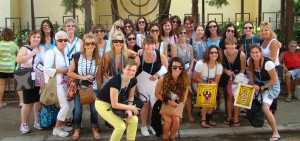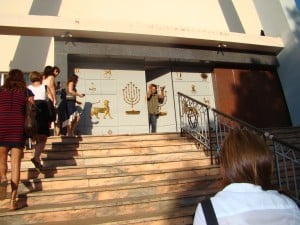Cuba? Bucket list?
Not on it for most of us, and by most of us, I mean the 28 women who signed on for last month’s United Jewish Federation of Tidewater’s/Joint Distribution Committee sponsored women’s mission to Havana Cuba, led by mission chairs Laura Gross and Jodi Klebanoff and Women’s Campaign director, Amy Zelenka. (A disclaimer or two: Sofia Konikoff is of Cuban decent and had been on prior Cuba Missions and so was a returning “daughter” of the island. And Sandy Katz, our JDC regional representative had also visited Cuba with other Jewish community missions.) The rest of us had no idea what we were in for.
The four-day visit to the Jewish community of Havana was eye-opening and inspiring.
After two pre-mission briefings, we had a rough idea of our itinerary. We were each asked to pack and bring medicines and supplies for the Jewish community’s central pharmacy (run out of one of Havana’s three synagogues)—everything from Tylenol and syringes to underwear and Chanukah dreidels! The medical supplies were collected and donated primarily by the medical professionals involved in UJFT’s Maimonides Society.
It was a little unnerving to consider that we were bringing these items into a country that had been subject to a U.S. trade embargo since the Cuban revolution and Castro’s rise to power. But we knew how important this contribution would be to their Jewish community and it was reassuring to have Sandy Katz with us, knowing that she had the long arm of the JDC at her disposal, should we run into any glitches (which we didn’t!). And we also knew that we’d be restricted to a mere 40 pounds of luggage including our care packages and handbags—talk about a selfless sorority soldiering the cause.
Upon our arrival, we knew we weren’t in Kansas anymore (or Norfolk, or any other U.S. city for that matter). Not that we were expecting the likes of Ricky Ricardo and his orchestra, but the atmosphere in the airport was strictly business. Once on the bus and on the road (after an hour delay for questioning by a customs official and the random search of two of our bags), a series of looming billboards, dark and foreboding, reminded all travelers of the cruel nature of the U.S. embargo, the most enduring in modern history. We would be reminded of this throughout our tour whether by present propaganda (such as the billboards), archived history in the museums, or just by our personal encounters.
“Ladies, Ladies, please may I have your attention?” Our charming and experienced Cuban guide, Alaine, was patient but persistent in his handling of a bus load of ladies. “What you need to do first and foremost upon visiting Havana is just simply take it all in. Look around you, visit with the people, experience where you are.”
That first piece of advice, while it had no way of stemming our first impressions as we entered the capital city, proved in the end to be the most penetrating and sage advice and something each and every one of us took home as a lasting souvenir.
What we saw initially and what we later came to experience were polar opposites. Entering Old Havana, once the largest collection of Spanish colonial architecture in all the Americas, the first things that caught our eyes were the beautifully restored, brightly colored 1950s sedans. It was a marvel to see them gliding down the streets. But, much like a scratch to the surface of those cars, what was eventually revealed was a city of neglect and decay. Magnificent baroque and neoclassical buildings were literally crumbling ruins. The economy was no better. The annual salary we were told averaged no more than $20 a month. Under Castro’s communist dictatorship, Cubans do not own their own homes and receive sparse food rations to supplement their sparse incomes. Restaurants are for tourists and there is a noticeable absence of boats in any harbor. We could only imagine how a small Jewish community was faring in this impoverished state.
What we saw in the Jewish community, the people we met, the leaders who presented, (primarily women and “Golda Meirs” each and every one!), the facilities, the activities, the vitality of the Cuban Jewish community, simply put, was nothing short of miraculous. Three small synagogues, one Orthodox, one Conservative, and one Sephardic, served the 1,100 or so Jewbans living within Havana (an estimated 400 or so also live elsewhere throughout the island.) We were privileged and honored to share Kabalat Shabbat services with the community. Later that evening we sat down with more than 100 of our new friends for a hot chicken dinner, and to enjoy a most genuine feeling of Jewish community; community born not only from JDC dollars—which are the result of Federation dollars— but also from JDC leadership.
Lulo, (short for Luciano), and Allie, a bright young Argentinean couple, are the JDC professionals currently assigned to serve the Cuban community. While we didn’t have the opportunity to meet Allie (she was home recovering from Dengue Fever), we spent a lot of time with Lulo. Both are shining examples of the kinds of energetic and hard-working young professionals that JDC places in Jewish communities around the world. Only one year into a two-year stay in Cuba, the couple is warmly regarded and highly respected by the entire Jewish community of Cuba. Lulo and Allie run a full spectrum of programming, serving all age groups within the community. Rotating such innovative counseling the community is exposed to fresh ideas and energies while relying on the continuity of its home grown outstanding leaders, elected presidents with life terms.
During our four action-packed days, we visited, discussed, ate, sang and danced with our Cuban counterparts. The Patranato (Grand Synagogue) housed the community’s make-shift pharmacy (one of the best-stocked pharmacies in all of Cuba, thanks to Jewish community missions, which come bearing much-needed medical supplies and medicines). The Sephardic Synagogue housed Cuba’s riveting Holocaust Remembrance Exhibit—one of only two in all of Latin America.
The Orthodox synagogue was located in what had been the original Jewish neighborhood of Havana, but what was now perhaps the poorest and most run-down section of the city. The sites, the smells, the sounds of that neighborhood will stay with all of us for a long, long time. During that walking tour, we were introduced to the “rationing centers” of Cuba, which display their wares in small glass bottles— indicating to Cuban citizens that ‘today we have corn meal, beans, and vegetable oil.’ Families of four are entitled to four times the ration; families of six get six times the ration, etc. The ration centers were threadbare, to say the least, and it was difficult for our group to imagine having to “shop” for groceries this way.
Perhaps most impressive was the realization that the Jewish community of Havana was being led by strong, smart, and visionary Jewish women. Adela Dworin, the long-time president of the Cuban Jewish community met with us before Shabbat. With incredible comic timing, she shared her amazing experiences (not the least of which included inviting and receiving Fidel Castro at one of the community’s Chanukah parties!). She talked about the challenges facing the community, including the country’s deplorable and dilapidated transportation system; the lack of reliable communication services. (NOTE: it was simultaneously strange and liberating to be “off the grid”—without cell phone or internet service for four days.). At the same time she spoke with pride about the country and its 99% literacy rate.
We were surprised to learn that dozens of the community’s young adults have participated in Birthright Israel and/or March of the Living missions. We were even more surprised to learn that the Cuban government allows Jews to make aliyah to Israel.
So, with losses due to death and aliyah, combined with a nearly 99% intermarriage rate, we wondered how the Jewish community of Cuba could continue to maintain its size. We learned that non-Jewish spouses of many intermarried couples end up converting after about five years of marriage. And so every few years, the community arranges for a rabbi to travel from Argentina to perform multiple chuppah weddings for these couples.
Moving slightly away from the Jewish community, our group visited the American Interest Section, located in the Swiss Embassy, which housed 51 U.S. diplomats (this despite the U.S. having no official diplomatic relations with the Cuban government). There we received a briefing on today’s Cuba—what life is like for the average Cuban, with many challenges and great potential, and also what the future may hold for Cuba and its relationship with the U.S.
Throughout the mission, our group walked the streets of Havana’s neighborhoods, stopping to peek in at museums and wrangle over prices with vendors in the markets and galleries. And yes, we did indulge in a few infamous Cuban cigars and Mojitos at the famed Hotel Nacional de Cuba whose notable guests over the years have included Jack Dempsey, Buster Keaton, Errol Flynn, Meyer Lansky, Winston Churchill, Betty Grable, Rita Hayworth, Ernest Hemingway, Fred Astaire, Gary Cooper, Frank Sinatra, Nat King Cole, Ava Gardner, Spencer Tracy, Marlon Brando, John Wayne, Mickey Mantle, and Walt Disney (to name a smattering). One particular evening saw our group “transported back in time” to the high stepping showy dance numbers and acrobatics of the famed Tropicana dancers. Speaking of Ricky Ricardo….
Our last evening was spent participating in a moving Havdala service at the Patronato. Strangers no longer, we sang and danced with our new friends. The youth groups performed Israeli dances with chins lifted high and smiles that infused us all with the indomitable spirit we all share as kindred Jews no matter our nationalities. Words could not express the emotions shared, although one single hand written letter tacked to a wall at the hall’s entrance came close:
“When I see how much cultural restoration has been performed by you and others, it reminds me again about why I am so proud to be a Jew. Thank you, Shalom”—Steven Spielberg
The continuity of community… a community of women…a community of Jewish women reaching out and embracing another community…a community striving to be self-sustaining. By the end of our short stay we had indeed come full circle. Our Cuban guide’s sage advice day one resonated and took on a whole new meaning by day four. By mission’s end, we had indeed taken in all that we experienced. The poverty that made us gasp at first glance had faded away. What we saw now took our breath away. In its place were men and women, teens and children, a community who, while not having much, certainly had each other.
by Kim Simon Fink






